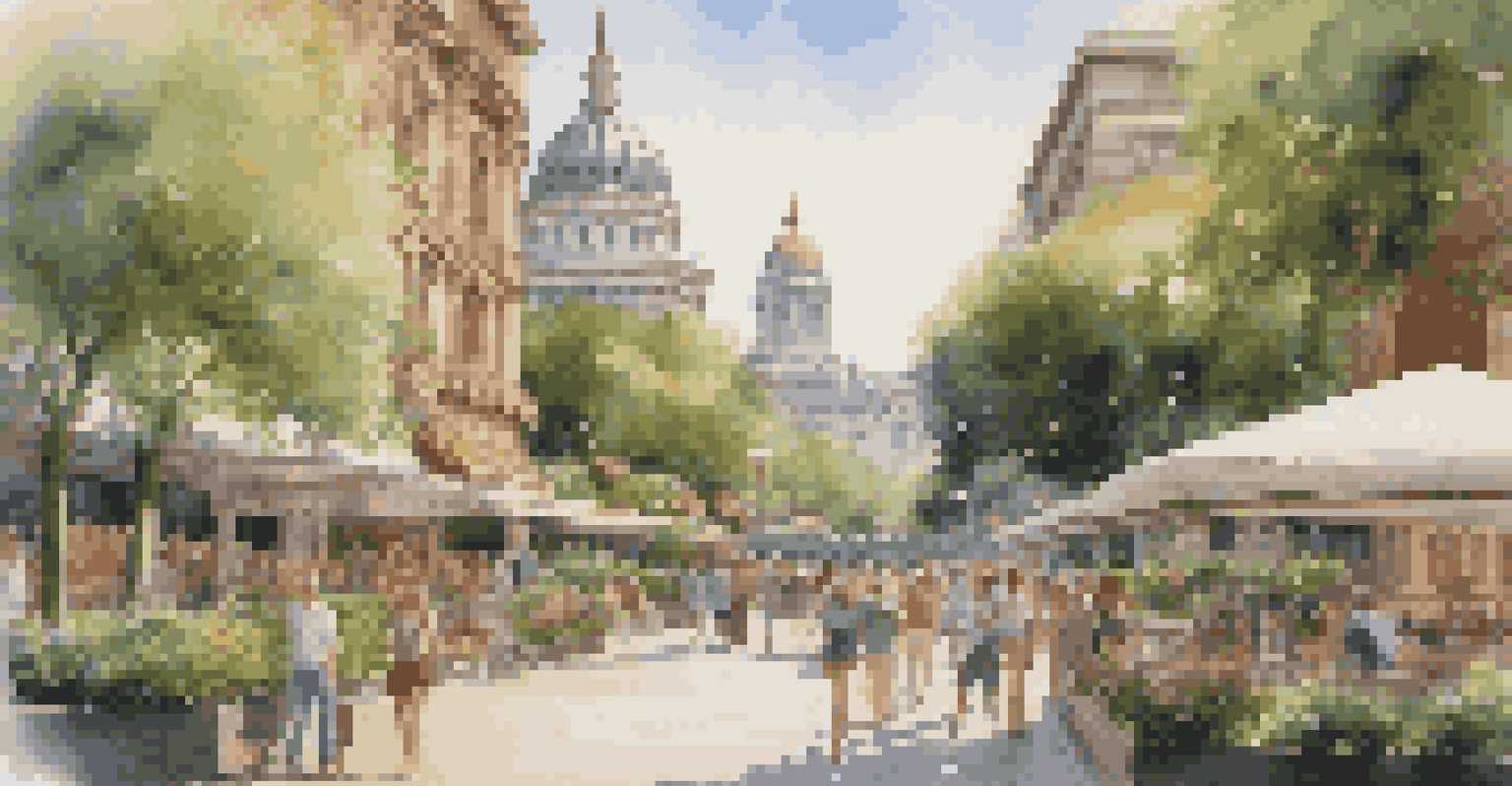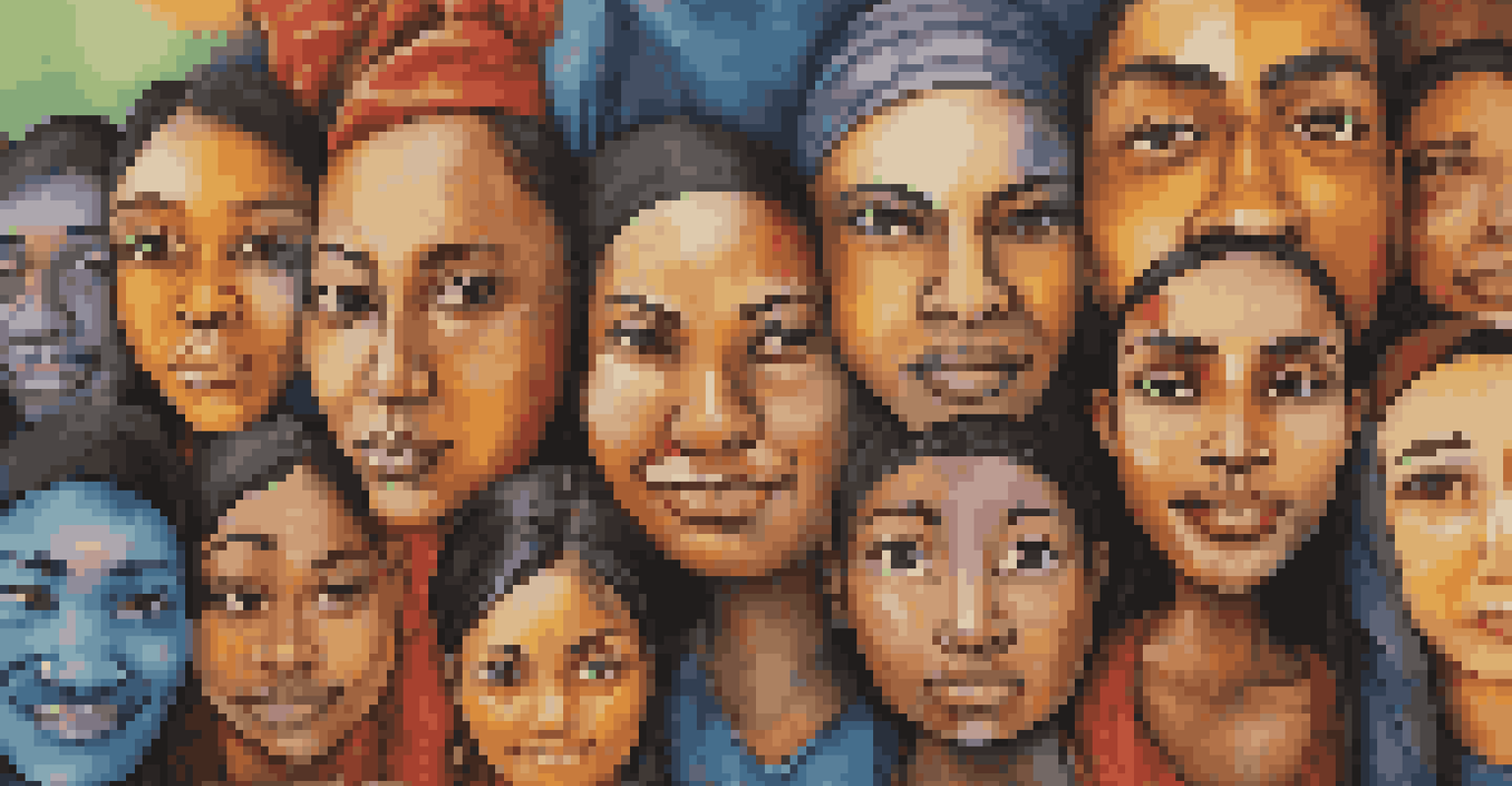The Representation of Urban Life in Contemporary Art

Understanding Urban Life in Contemporary Art
Contemporary art often serves as a mirror reflecting the complexities of urban life. As cities become the epicenters of culture and diversity, artists capture the essence of these experiences in their work. Urban life, with its fast pace and dynamic atmosphere, provides a rich tapestry for creative expression.
Art should comfort the disturbed and disturb the comfortable.
Artists like Banksy and Kehinde Wiley draw inspiration from urban settings, intertwining social commentary with vibrant visuals. Their works evoke a sense of place, inviting viewers to engage with the stories of the city. By documenting the hustle and bustle of urban environments, these artists highlight both the beauty and struggles inherent in city living.
Furthermore, the representation of urban life in art can foster a sense of community. When people see their own experiences reflected in art, it creates a shared connection, bridging gaps between various cultures and backgrounds. This dialogue between the artwork and the viewer is crucial in understanding contemporary urban narratives.
The Role of Street Art in Urban Representation
Street art has emerged as a powerful form of expression that captures the spirit of urban life. Often created in public spaces, it engages the community directly, transforming mundane cityscapes into vibrant galleries. This accessibility makes street art an essential medium for artists who wish to convey messages about social issues, identity, and the environment.

Artists like Shepard Fairey and JR use their street art to address societal challenges, from inequality to environmental concerns. Their work encourages conversation and reflection among passersby, making art an active participant in the urban dialogue. This immediacy is what sets street art apart from traditional forms of artistic expression.
Art Mirrors Urban Life's Complexity
Contemporary art reflects the multifaceted experiences of urban living, capturing both its beauty and challenges.
Moreover, street art often reflects the diverse voices within a city, celebrating cultural richness and local stories. By representing various perspectives, it fosters inclusivity and allows marginalized communities to share their experiences. In this way, street art becomes a vital tool for social change, highlighting the importance of representation in urban life.
Urban Landscapes: A Canvas for Artistic Expression
Urban landscapes frequently serve as a canvas for contemporary artists, offering endless opportunities for exploration. Artists like Edward Hopper and Richard Estes capture the essence of city life through detailed depictions of urban settings. Their work evokes a sense of familiarity, allowing viewers to connect emotionally with the depicted environments.
The role of the artist is to make the revolution irresistible.
Through various mediums, from painting to photography, artists emphasize the unique character of cities. They highlight architectural elements, public spaces, and everyday moments that often go unnoticed. By focusing on these details, artists invite us to appreciate the beauty in the ordinary aspects of urban existence.
Additionally, urban landscapes can reflect broader societal changes and challenges. For instance, the impact of gentrification or environmental degradation is often evident in the shifting urban fabric. Artists have the power to document and critique these transformations, making their work not only visually striking but also socially relevant.
Contemporary Art and Social Issues in Cities
Contemporary art often addresses pressing social issues that affect urban environments, such as poverty, inequality, and displacement. Artists serve as advocates, using their work to shine a light on these critical topics. For example, the work of Ai Weiwei confronts issues of human rights and freedom of expression, resonating deeply within urban contexts.
By tackling these subjects, artists encourage viewers to reflect on their roles within the city and society at large. This engagement can prompt conversations about change and inspire action among those who encounter the artwork. The fusion of art and activism creates a powerful platform for raising awareness.
Street Art Fosters Community Voices
Street art serves as an accessible platform for diverse communities to express their stories and social issues.
Moreover, the representation of social issues in contemporary art can foster empathy and understanding. When people witness the struggles and triumphs of others through artistic expression, it humanizes complex social dynamics. This connection is particularly vital in diverse urban settings, where varying experiences coexist.
The Influence of Technology on Urban Art
Technology has substantially influenced contemporary urban art, from creation to distribution. Digital tools allow artists to experiment with new techniques, pushing the boundaries of traditional art forms. For instance, augmented reality (AR) can transform public spaces into interactive art experiences, captivating audiences in innovative ways.
Social media platforms also play a pivotal role in the dissemination of urban art. Artists can share their work with a global audience, gaining recognition beyond their local communities. This accessibility has fostered a new generation of artists who leverage technology to amplify their voices and reach wider audiences.
However, the digital age also presents challenges, such as issues of authenticity and ownership. As art becomes increasingly consumed online, questions arise about its value and impact. Nevertheless, technology continues to shape the landscape of urban art, creating new opportunities for artists to engage with their environments.
The Cultural Diversity of Urban Art
Urban art thrives on cultural diversity, drawing inspiration from the myriad influences present in cities. Artists from various backgrounds contribute unique perspectives, enriching the artistic landscape. This cultural exchange fosters creativity and innovation, resulting in dynamic and thought-provoking works.
For example, the fusion of different artistic styles, such as graffiti and traditional painting, reflects the multicultural fabric of urban life. Artists often incorporate elements from their heritage, creating pieces that resonate with their communities. This blending of styles not only celebrates diversity but also highlights shared experiences and narratives.
Technology Shapes Urban Artistic Expression
Advancements in technology are transforming how urban art is created and shared, allowing for innovative engagement with audiences.
Moreover, the cultural diversity found in urban art encourages dialogue among different groups. Art becomes a medium for storytelling, allowing individuals to share their histories and experiences. This exchange promotes understanding and unity, essential components in navigating the complexities of urban life.
The Future of Urban Representation in Art
As cities continue to evolve, so too will the representation of urban life in contemporary art. Artists will likely respond to emerging challenges, such as climate change, social justice, and technological advancements. This adaptability is crucial, as art not only reflects the present but also shapes future narratives.
Furthermore, the integration of new technologies will continue to expand artistic possibilities. Virtual reality (VR) and interactive installations may become more prevalent, offering immersive experiences that engage viewers in novel ways. This evolution will enhance the connection between art and urban life, allowing for deeper exploration of the topics that matter most.

Ultimately, the future of urban representation in art lies in its ability to inspire change. By addressing contemporary issues and celebrating the diversity of urban experiences, artists will continue to play a vital role in shaping how we understand our cities and communities. Their work will remind us that art is not just a reflection of life, but a catalyst for transformation.